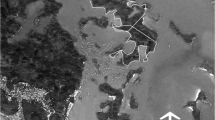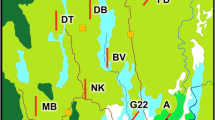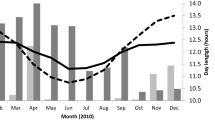Abstract
We collected data on diet and daytime activity budget, and investigated the phenology of food trees and food abundance for a group of Rhinopithecus roxellana on the East Ridge of Yuhuangmiao in the Qinling Mountains from November 2001 to December 2003. We calculated the seasonal activity budget using data collected by scan sampling from 84 full-day observations (winter 16, spring 18, summer 28, autumn 22 days). During scan sampling we recorded behavioral states, and the food items and species consumed. The subjects consumed 84 plant species, including trees and shrubs of 29 families, and lichens. Food species varied seasonally. The overall diet of R. roxellana consisted of 29.4% fruit/seeds, 29.0% lichens, 24.0% leaves, 11.1% bark, 4.2% buds, 1.3% twigs and 1.0% unidentified items. Because the abundance of different food items varied seasonally, the monkeys had to shift their major food items seasonally. The annual activity budget of R. roxellana was 36.2% time spent resting, 35.8% feeding, 22.9% moving, and 5.1% other behavior. Seasonal changes in activity budget were observed. R. roxellana spent more time moving in autumn, when the quality of the food might be highest, and least time moving in winter when the food quality might be lowest. Thus, this type of monkey has a passive foraging strategy.




Similar content being viewed by others
References
Agetsuma N (1995) Foraging strategies of Yakushima macaques (Macacafuscata yakui). Int J Primatol 16:595–609
Agetsuma N, Nakagawa N (1998) Effects of habitat differences on feeding behaviors of Japanese monkeys: comparison between Yakushima and Kinkazan. Primates 39:275–289
Altmann SA (1974) Baboons: space, time, and energy. Am Zool 14:221–248
Boonratana R, Le XC (1998) Preliminary observation of the ecology and behavior of the Tonkin snub-nosed monkey (Rhinopithecus avunculus) in northern Vietnam. In: Jablonski NC (ed) The natural history of the doucs and snub-nosed monkeys. Word Scientific Publishing, Singapore, pp 207–215
Bleisch WV, Xie JH (1998) Ecology and behavior of the Guizhou snub-nosed langur (Rhinopithecus [Rhinopithecus] brelichi), with a discussion of socioecology in the genus. In: Jablonski NG (ed) The natural history of the doucs and snub-nosed monkeys. World Scientific Publishing, Singapore, pp 217–239
Bleisch W, Cheng AS, Ren XD, Xie JH (1993) Preliminary results from a field study of wild Guizhou snub-nosed monkeys (Rhinopithecus brelichi). Folia Primatol 60:72–82
Chen FG, Min ZL, Luo SY, Xie WZ (1982) Resources and protection of the golden monkey (Rhinopithecus roxellana) in Qinling Mountains (in Chinese with English abstract). Acta Theriol Sinica 3:141–146
Clutton-Brock TH (1977) Some aspects of intraspecific variation in feeding and ranging behavior in primates. In: Clutton-Brock TH (ed) Primate ecology. Academic, New York, pp 539–556
Curtin RA (1982) Range use of gray langurs in highland Nepal. Folia Primatol 38:1–18
Dasilva GL (1992) The western black-and-white colobus as a low-energy strategist: activity budget, energy expenditure and energy intake. J Anim Ecol 61:79–91
Dasilva GL (1994) Diet of Colobus polykomos on Tiwai Island: selection of food in relation to its seasonal abundance and nutritional quality. Int J Primatol 15:655–680
Defler TR (1995) The time budget of a group of wild woolly monkeys (Lagothrix lagotricha). Int J Primatol 16:107–120
Ding W, Zhao QK (2004) Rhinopithecus bieti at Tacheng, Yunnan: diet and daytime activities. Int J Primatol 25:583–598
Fashing PJ (2001) Feeding ecology of Guerezas in the Kakamega forest, Kenya: the importance of Moraceae fruit in their diet. Int J Primatol 22:579–609
Guo ST (2004) Research on the feeding and ranging behaviors of golden monkeys (Rhinopithecus roxellana) of Qinling Mountains (in Chinese with English abstract). MS Thesis, Northwest University, Xi’an
Hall KRL (1962) Numerical data, maintenance activities and locomotion in the wild chacma baboon, Papio ursinus. Proc Zool Soc Lond 139:181–220
Harrison MJS (1985) Time budget of the green monkey, Cercopithecus sabacus: some optimal strategies. Int J Primatol 6:351–376
Harvey PH (1985) When the going gets tough. Nature 317:388–389
Hill DA (1997) Seasonal variation in the feeding behavior and diet of Japanese Macaques in lowland forest of Yakushima. Am J Primatol 43:305–322
Hladik CM (1988) Seasonal variations in food supply for wild primates. In: de Garine I, Harrison GA (eds) Coping with uncertainty in food supply. Clarendon Press, Oxford, pp 1–25
Hu JC, Deng QX, Yu ZW, Zhou SD, Tian ZX (1980) Study on ecobiology of rare animals, giant panda, golden monkey, etc. (in Chinese with English abstract). J Nanchong Teacher’s University 2:1–38
Jablonski NG (1998) The evolution of the doucs and snub-nosed monkey and the question of the phyletic unity of the odd-nosed colobines. In: Jablonski NC (ed) The natural history of the doucs and snub-nosed monkeys. Word Scientific Publishing, Singapore, pp 13–52
Kirkpatrick RC (1998) Ecology and behavior in snub-nosed monkey and douc langurs. In: Jablonski NC (ed) The natural history of the doucs and snub-nosed monkeys. Word Scientific Publishing, Singapore, pp 155–190
Kirkpatrick RC, Gu HJ, Zhou XP (1999) A preliminary report on Sichuan snub-nosed monkey (Rhinopithecus roxellana) at Baihe nature reserve. Folia Primatol 70:117–120
Li YM (2001) The seasonal diet of the Sichuan snub-nosed monkey (Pygathrix roxellana) in Shennongjia Nature Reserve, China. Folia Primatol 72:40–43
Li YM (2002) The seasonal daily travel in a group of Sichuan snub-nosed monkey (Pygathrix roxellana) in Shennongjia Nature Reserve, China. Primates 43:271–276
Li YM (2006) Seasonal variation of diet and food availability in a group of Sichuan snub-nosed monkeys in Shennongjia Nature Reserve, China. Am J Primatol 68:217–233
Li BG, Cheng C, Ji WH, Ren BP (2000) Seasonal home range changes of the Sichuan snub-nosed monkey (Rhinopithecus roxellana) in the Qinling Mountains of China. Folia Primatol 71:375–386
Li BG, Jia ZY, Pan RL, Ren BP (2003a) Changes in distribution of the snub-nosed monkey in China. In: Marsh LK (ed) Primates in fragments: ecology and conservation. Kluwer, New York, pp 29–51
Li BG, Zhang P, Watanabe K, Tan CL, Fukuda F, Wada K (2003b) A dietary shift in Sichuan snub-nosed monkeys. Acta Theriol Sinica 23:358–360
Lippold LK (1977) The douc langur: a time for conservation. In: Rainier HSHP, Bourne GH (eds) Primate conservation. Academic, New York, pp 513–538
Marsh CW (1981) Time budget of Tana River red colobus. Folia Primatol 35:30–50
Mehlman PT (1988) Food resources of the wild Barbary macaque (Macaca sylvanus) in high altitude fir forest, Ghomaran Rif, Morocco. J Zool 214:469–490
Milton K (1980) The foraging strategy of howler monkeys. Columbia University Press, New York
Nakagawa N (1989) Feeding strategies of Japanese monkeys against deterioration of habitat quality. Primates 30:1–16
Norberg RA (1977) An ecological theory on foraging time and energetic and choice of optimal food-searching method. J Anim Ecol 46:511–529
O’Brien TG, Kinnaird MF (1997) Behavior, diet, and movements of the Sulawesi crested black macaque (Macaca nigra). Int J Primatol 18:321–351
Oates JF (1987) Food distribution and foraging behavior. In: Smuts BB, Cheney DL, Seyfarth RM, Struhsaker T, Wrangham RW (eds) Primate societies. University of Chicago Press, Chicago, pp 197–209
Oates JF (1994) The natural history of African colobines. In: Davies AG, Oates JF (eds) Colobine monkeys: their ecology, behavior and evolution. Cambridge University Press, London, pp 75–128
Peres CA (1993) Diet and feeding ecology of saddleback (Saguinus fuscicollis) and moustached (S. mystax) tamarins in an Amazonian terra firma forest. J Zool 230:567–592
Post D (1981) Activity patterns of yellow baboons (Papio cynocephalus) in the Amboseli National Park, Kenya. Anim Behav 29:357–374
Passamani M (1998) Activity budget of Geoffroy’s Marmoset (Callithrix geoffroyi) in an Atlantic forest in southeastern Brazil. Am J Primatol 46:333–340
Raemaekers J (1980) Causes of variation between months in the distance traveled daily by gibbons. Folia Primatol 34:46–60
Shi DT, Li GH, Hu TT (1982) Preliminary studies on the ecology of the golden-haired monkey (in Chinese with English abstract). Zool Res 3:105–110
Sourd C, Gautier-Hion A (1986) Fruit selection by a forest guenon. J Anim Ecol 55:235–244
Stanford CB (1991) The capped langur in Bangladesh: behavior ecology and reproductive tactics. In: Slazay FS (eds) Contribution to primatology, vol 26. Karger, Basel, pp 1–179
Su YJ, Ren RM, Yan KH, Li JJ, Zhou Y, Zhu ZQ, Hu ZL, Hu YF (1998) Preliminary survey of the home range and ranging behavior of golden monkeys (Rhinopithecus roxellana) in Shennongjia National Natural Reserve, Hubei, China. In: Jablonski NG (ed) The natural history of the douc and snub-nosed monkeys. Word Scientific Publishing, Singapore, pp 255–268
Tan CL, Guo ST, Li BG (2007) Population structure and ranging patterns of Sichuan snub-nosed monkeys (Rhinopithecus roxellana) in Zhouzhi National Nature Reserve, Shaanxi, China. Int J Primatol (in press)
Vasey N (2005) Activity budgets and activity rhythms in red ruffed lemurs (Varecia rubra) on the Masoala Peninsula, Madagascar: seasonality and reproductive energetic. Am J Primatol 66:23–44
Watanuki Y, Nakayama Y (1993) Age difference in activity pattern of Japanese monkeys: effects of temperature, snow and diet. Primates 34:419–430
Wu BQ (1993) Patterns of spatial dispersion, locomotion and foraging behavior in three groups of Yunnan snub-nosed langur (Rhinopithecus bieti). Folia Primatol 60:63–71
Zhang P, Li BG, Wada K, Tan CL, Watanabe K (2003) Social structure of Sichuan snub-nosed monkeys Rhinopithecus roxellana in the Qinling Mountains of China (in Chinese with English abstract). Acta Zool Sinica 49:727–735
Acknowledgments
We thank Zhouzhi National Nature Reserve for permission to conduct this study. We are most grateful to Wang QC and Liang YL, for their arduous efforts in tracking the monkey troop, Professor Yang PH of Northwest Agriculture and Forest University, for identifying plant specimens, and Wada K and several Northwest University students, for their assistance in the field work. We also thank Tan CL, Rogers ME, Phillips JA, and White D for providing helpful comments on earlier drafts of the manuscript. This study was supported by the National Nature Science Foundation of China (30370202, 30570312 and 30630016), Primate Conservation, Inc., COSMO Oil Eco Card Foundation, and the Zoological Society of San Diego.
Author information
Authors and Affiliations
Corresponding author
About this article
Cite this article
Guo, S., Li, B. & Watanabe, K. Diet and activity budget of Rhinopithecus roxellana in the Qinling Mountains, China. Primates 48, 268–276 (2007). https://doi.org/10.1007/s10329-007-0048-z
Received:
Accepted:
Published:
Issue Date:
DOI: https://doi.org/10.1007/s10329-007-0048-z




